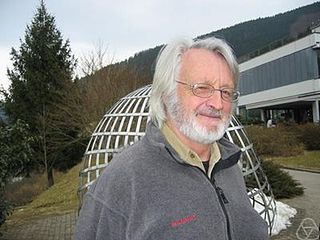Related Research Articles
Society for Industrial and Applied Mathematics (SIAM) is a professional society dedicated to applied mathematics, computational science, and data science through research, publications, and community. SIAM is the world's largest scientific society devoted to applied mathematics, and roughly two-thirds of its membership resides within the United States. Founded in 1951, the organization began holding annual national meetings in 1954, and now hosts conferences, publishes books and scholarly journals, and engages in advocacy in issues of interest to its membership. Members include engineers, scientists, and mathematicians, both those employed in academia and those working in industry. The society supports educational institutions promoting applied mathematics.
John Emory Dennis, Jr. is an American mathematician who has made major contributions in mathematical optimization. Dennis is currently a Noah Harding professor emeritus and research professor in the department of computational and applied mathematics at Rice University in Houston, Texas. His research interests include optimization in engineering design. He is the founder and editor-in-chief of the SIAM Journal on Optimization. In 2010, he was elected a Fellow of the Society for Industrial and Applied Mathematics.
Roger Meyer Temam is a French applied mathematician working in numerical analysis, nonlinear partial differential equations and fluid mechanics. He graduated from the University of Paris – the Sorbonne in 1967, completing a doctorate under the direction of Jacques-Louis Lions. He has published over 400 articles, as well as 12 books.

Randall J.. LeVeque is a Professor of Applied Mathematics at University of Washington who works in many fields including numerical analysis, computational fluid dynamics, and mathematical theory of conservation laws. Among other contributions, he is lead developer of the open source software project Clawpack for solving hyperbolic partial differential equations using the finite volume method. With Zhilin Li, he has also devised a numerical technique called the immersed interface method for solving problems with elastic boundaries or surface tension.
Burton Wendroff is an American applied mathematician known for his contributions to the development of numerical methods for the solution of hyperbolic partial differential equations. The Lax–Wendroff method for the solution of hyperbolic PDE is named for Wendroff.

Frank Natterer is a German mathematician. He was born in Wangen im Allgäu, Germany. Natterer pioneered and shaped the field of mathematical methods in imaging including computed tomography (CT), magnetic resonance imaging (MRI) and ultrasonic imaging.
Irena Lasiecka is a Polish-American mathematician, a Distinguished University Professor of mathematics and chair of the mathematics department at the University of Memphis. She is also co-editor-in-chief of two academic journals, Applied Mathematics & Optimization and Evolution Equations & Control Theory.
Joseph Pierre LaSalle was an American mathematician specialising in dynamical systems and responsible for important contributions to stability theory, such as LaSalle's invariance principle which bears his name.

Jack Kenneth Hale was an American mathematician working primarily in the field of dynamical systems and functional differential equations.
Peter John Olver is a British-American mathematician working in differential geometry.
Margaret Cheney is an American mathematician whose research involves inverse problems. She is Yates Chair and Professor of Mathematics at Colorado State University.
The W. T. and Idalia Reid Prize is an annual award presented by the Society for Industrial and Applied Mathematics (SIAM) for outstanding research in, or other contributions to, the broadly defined areas of differential equations and control theory. It was established in 1994 in memory of long-time University of Oklahoma mathematics professor W. T. Reid, who died in 1977.
Ruth F. Curtain was an Australian mathematician who worked for many years in the Netherlands as a professor of mathematics at the University of Groningen. Her research concerned infinite-dimensional linear systems.
Weizhu Bao is a Chinese mathematician at the National University of Singapore (NUS). He is known for his work in applied mathematics with applications in quantum physics and chemistry and materials science, especially Bose-Einstein condensation (BEC) and highly oscillatory partial differential equations.
Frank "Francis" H. Clarke is a Canadian and French mathematician.
Panagiotis E. Souganidis is an American mathematician, specializing in partial differential equations.

Christian Lubich is an Austrian mathematician, specializing in numerical analysis.
PDE-constrained optimization is a subset of mathematical optimization where at least one of the constraints may be expressed as a partial differential equation. Typical domains where these problems arise include aerodynamics, computational fluid dynamics, image segmentation, and inverse problems. A standard formulation of PDE-constrained optimization encountered in a number of disciplines is given by:

Gerhard Wanner is an Austrian mathematician.

Guillaume Carlier is a French mathematician. Most of his work lies in the field of calculus of variation and optimization. He is a professor of applied mathematics at Paris Dauphine University and a researcher at Mokaplan, a joint INRIA-CNRS-Université Paris-Dauphine team dedicated to research in the field of optimal transport.
References
- ↑ "Karl Kunisch's CV" (PDF). 2021-10-31.
- ↑ "Karl Kunisch's publication list". 2021-10-31.
- ↑ "SFB Homepage". 2021-09-05.
- ↑ "Preisträger*innen Robert-Piloty Preis" (in German). 2021-10-31.
- ↑ "ICM Plenary and Invited Speakers". 2021-10-31.
- ↑ "ERC Advanced Grants 2015" (PDF). 2021-10-31.
- ↑ "SIAM > Prizes & Recognition > Fellows Program > All SIAM Fellows > Class of 2017". 2021-09-05.
- ↑ "W. T. and Idalia Reid Prize". 2021-09-05.